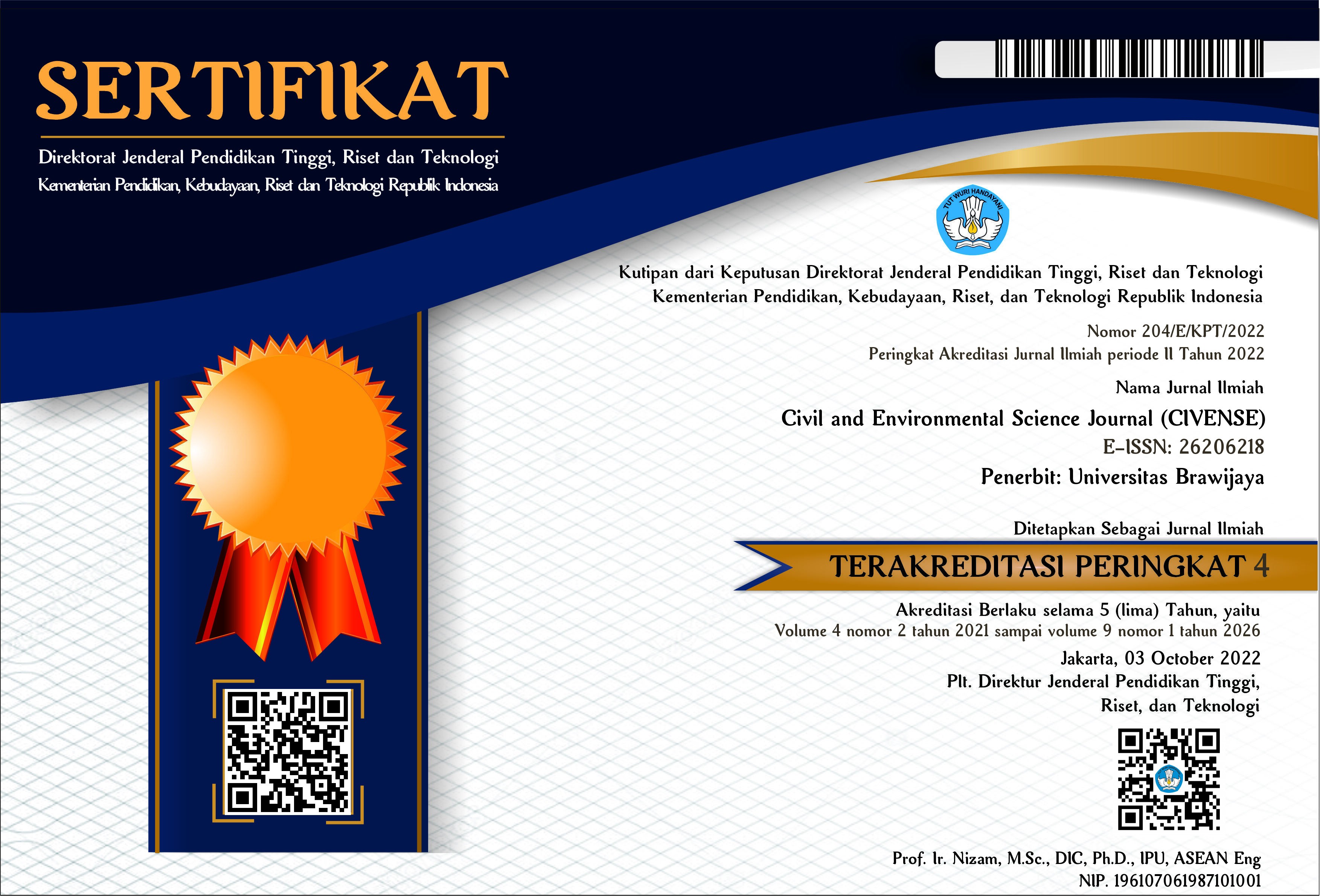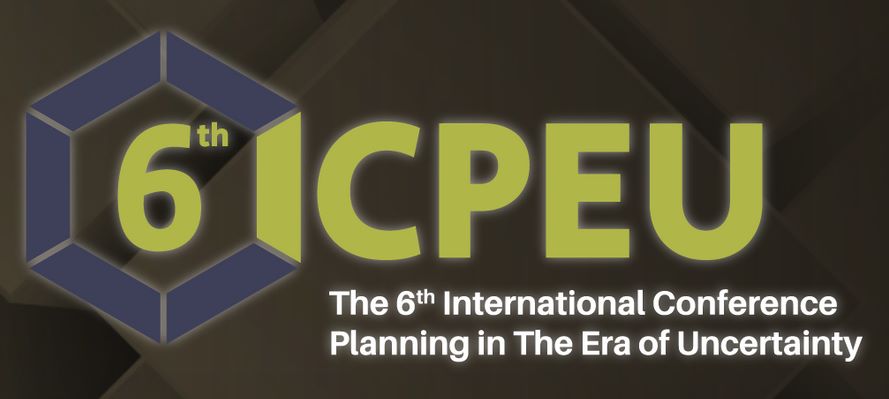Performance of multi-soil-layering (MSL) urban domestic wastewater treatment system
DOI:
https://doi.org/10.21776/ub.civense.2020.00301.5Keywords:
Multi-soil-layering, wastewater treatment, domestic wastewaterAbstract
This research has the objective of examining the efficiency optimization of a multisoil-layering (MSL) system in three stages through the selection of the most efficient material for permeable layers. The utilized charcoal variations were coconut shell charcoal, rice husk charcoal, and corncob charcoal. The utilized incoming discharge for Q1 and Q2 were 0.0063 L/second and 0.0126 L/second. In the first stage of processing, the pumice and zeolite in Q1 had not been able to reduce the TSS below the quality standard, while silica sand in both discharges were still in accordance with the quality standard. In the second stage of processing, Q1 MSL A-s had the best elimination capability, with the efficiencies of TDS, TSS, pH, and DO respectively being 18.13%, 79.68%, 2.60%, and 126.67%, while for Q2, they were 29.99%, 77.76%, 1.62%, and 95.80%. In the third stage, it was shown that MSL B-m was the most optimal reactor compared to all reactors that had their water qualities measured. For Q1 for MSL B-m, the parameters of TDS, TSS, pH, and DO were respectively 33.16%, 84.32%, 1.29%, and 126.67%, and for Q2 they were 30.80%, 80.54%, 1.50%, and 112.30%. In the third stage of processing, MSL A-m, MSL B-m, and MSL C-m that included the addition of soil mixtures and modifications of soil mixture blocks could increase the efficiency of each parameter and had a more stable quality of water outflow compared to standard MSL; this is because the incoming water flow was slower, which caused water contact with the processing media to be more optimal.References
An, C.J., McBean, E., Huang, G.H., Yao, Y., Zhang, P., Chen, X.J., Li, Y.P. 2016. Multi-Soil-Layering Systems For Wastewater Treatment In Small And Remote Communities. J. Environm. Inf. 27, 131–144. http://dx.doi.org/10.3808/jei.201500328.
An, C.J., McBean, E., Huang, G.H., Yao, Y., Zhang, P., Chen, X.J., Li, Y.P. 2016. Multi-Soil-Layering Systems For Wastewater Treatment In Small And Remote Communities. J. Environm. Inf. 27, 131–144. http://dx.doi.org/10.3808/jei.201500328.
Guan, Y., Zhang, Y., Zhong, C.N., Huang, X.F., Fu, J., Zhao, D. 2015. Effect Of Operating Factors On The Contaminants Removal Of A Soil Filter: Multi-Soil-Layering System. Environ. Earth Sci. 74 (3), 2679–2686. http://dx.doi.org/10.1007/s12665-015-4288-8.
Lestari, H., Haribowo, R., & Yuliani, E. (2019). Determination of Pollution Load Capacity Using QUAL2Kw Program on The Musi River Palembang. Civil and Environmental Science Journal, 2(2), pp.105-116. doi:https://doi.org/10.21776/ub.civense.2019.00202.4
Latrach, L., Ouazzani, N., et al. 2018. Optimization Of Hydraulic Efficiency And Wastewater Treatment Performances Using A New Design Of Vertical Flow Multi-Soil-Layering (MSL) Technology Ecological Engineering. 140-152. https://doi.org/10.1016/j.ecoleng.2018.04.003
Latrach, L., Masunaga, T., Ouazzani, N., Hejjaj, A., Mahi, M., Mandi, L., 2015. Removal Of Bacterial Indicators And Pathogens From Domestic Wastewater By The Multi-Soil Layering (MSL) System. Soil Sci. Plant Nutr. 61, 337–346. http://dx.doi.org/10.1080/ 00380768.2014.974480.
Megah, S., Rosita, W., Haribowo., R. 2018. Efisiensi Pengolahan Limbah Domestik Menggunakan Metode Multi Soil Layering (MSL). Jurnal Teknik Pengairan Universitas Brawijaya, 1-13.
Mutia, R., Elystia, S., Yenie, E. 2015. Metode Multi Soil Layering Dalam Penyisihan Parameter TSS Limbah Cair Kelapa Sawit Dengan Variasi Hydraulic Loading Rate (HLR) Dan Material Organik Pada Lapisan Anaerob. Jom FTEKNIK Volume 2 No. 1 Februari 2015. 1-6.
Riyanto H, Minami Y, Masahiko S, Tsuyoshi I, Koichi Y, Takaya H, Ariyo K 2017 Behavior of toxicity in river basins dominated by residential areas Contemporary Engineering Sciences 10 (7), 305-315.
R Haribowo, V Dermawan, SN Yudha., 2018. Application of Artificial Neural Network For Defining The Water Quality in The River. Civil and Environmental Science Journal 1 (01), 12-18, 2018.
Yamashita H, Haribowo R, Sekine M, Oda N, Kanno A, Shimono Y 2012 Toxicity test using medaka (Oryzias latipes) early fry and concentrated sample water as an index of aquatic habitat condition Environmental Science and Pollution Research 19 (7), 2581-2594.
Deshpande, V. V., & Thorvat, A. R. (2018). Experimental Investigation of Treatment of Domestic Wastewater Using Multi Soil Layering (MSL) System. Aquademia: Water, Environment and Technology, 2(2), 05. https://doi.org/10.20897/awet/3963.
Yidong Guan, Chen Xin, Zhang Shuai, Luo Ancheng. 2012. Performance of multi-soil-layering system (MSL) treating leachate from rural unsanitary landfills. Science of The Total Environment 420:183-90. DOI: 10.1016/j.scitotenv.2011.12.057
Downloads
Published
How to Cite
Issue
Section
License
Copyright (c) 2020 Civil and Environmental Science Journal

This work is licensed under a Creative Commons Attribution-NonCommercial 4.0 International License.
Authors who publish with this journal agree to the following terms:
Authors retain copyright and grant the journal right of first publication with the work simultaneously licensed under a Attribution-NonCommercial 4.0 International License that allows others to share the work with an acknowledgement of the work's authorship and initial publication in this journal.
Authors are able to enter into separate, additional contractual arrangements for the non-exclusive distribution of the journal's published version of the work (e.g., post it to an institutional repository or publish it in a book), with an acknowledgement of its initial publication in this journal.
Authors are permitted and encouraged to post their work online (e.g., in institutional repositories or on their website) prior to and during the submission process, as it can lead to productive exchanges, as well as earlier and greater citation of published work (See the Effect of Open Access).














